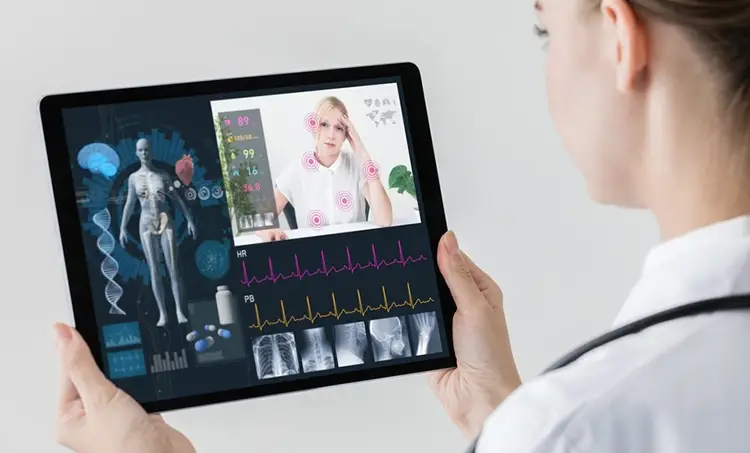Transforming Healthcare: A Comprehensive Exploration of Telemedicine and Remote Healthcare Services
Introduction:
The landscape of healthcare is undergoing a profound transformation with the rapid evolution of telemedicine and remote healthcare services. As technological advancements continue to reshape various sectors, the integration of telemedicine into the fabric of healthcare delivery has emerged as a pivotal force. This article aims to delve into the multifaceted realm of telemedicine, exploring its definition, historical evolution, applications, benefits, challenges, and the transformative impact it holds for the future of healthcare.
Defining Telemedicine:
Telemedicine, at its core, refers to the use of telecommunications technology to provide healthcare services remotely. This encompasses a wide range of applications, from virtual consultations and remote monitoring to the exchange of medical information for diagnosis and treatment. The advent of digital communication technologies has propelled telemedicine beyond its early iterations, enabling healthcare professionals to connect with patients in real-time and deliver care irrespective of geographical distances.
Historical Evolution:
The roots of telemedicine can be traced back to the mid-20th century when communication technologies began to facilitate the exchange of medical information over distances. The term “telemedicine” was coined in the 1970s, marking the formal recognition of the field. Early telemedicine initiatives involved the transmission of radiographic images and consultations via telephone lines.
The evolution of telemedicine gained momentum with the widespread adoption of the internet and advancements in video conferencing technologies. As high-speed internet became more accessible, the possibilities for real-time, visual interactions between healthcare providers and patients expanded, laying the groundwork for the modern era of telemedicine.
Applications of Telemedicine:
- Virtual Consultations: Telemedicine enables healthcare providers to conduct virtual consultations with patients, allowing for remote diagnosis, treatment planning, and follow-up care. Video conferencing platforms facilitate face-to-face interactions, bridging the gap between patients and healthcare professionals.
- Remote Patient Monitoring: With the integration of wearable devices and sensors, telemedicine extends to remote patient monitoring. Individuals with chronic conditions can transmit vital signs, such as blood pressure, heart rate, and glucose levels, to healthcare providers in real-time, enabling proactive management of health conditions.
- Telepsychiatry and Mental Health Services: Telemedicine plays a crucial role in providing mental health services, allowing patients to access psychiatrists, psychologists, and counselors remotely. This is particularly valuable for individuals in remote areas or those facing barriers to in-person mental health services.
- Teleradiology: The transmission of medical images, such as X-rays, CT scans, and MRIs, for remote interpretation by radiologists falls under the domain of teleradiology. This application of telemedicine enhances diagnostic capabilities and facilitates timely decision-making.
- Telestroke Services: In cases of stroke, where time is of the essence, telestroke services enable remote consultations with neurologists. This rapid access to specialized care can significantly improve outcomes for stroke patients.
- E-Consultations and Second Opinions: Telemedicine facilitates e-consultations, enabling healthcare professionals to collaborate and seek second opinions from specialists, regardless of geographical distances. This enhances the quality and comprehensiveness of patient care.
- Telepharmacy: Telemedicine extends to pharmacy services, allowing patients to consult with pharmacists remotely. This includes medication reviews, counseling, and prescription management, contributing to medication adherence and safety.

Benefits of Telemedicine:
- Increased Access to Healthcare: Telemedicine addresses the challenge of geographical barriers, bringing healthcare services to individuals in remote or underserved areas. This increased accessibility is particularly beneficial for those living in rural regions where access to healthcare facilities may be limited.
- Convenience for Patients: Virtual consultations provide unparalleled convenience for patients. The ability to connect with healthcare providers from the comfort of their homes eliminates the need for travel, reducing time and costs associated with in-person visits.
- Timely Access to Specialized Care: Telemedicine facilitates timely access to specialized care, especially in cases where immediate intervention is crucial, such as stroke or mental health emergencies. This rapid access to expertise can significantly impact patient outcomes.
- Cost Savings: Both patients and healthcare systems can experience cost savings through telemedicine. Patients save on travel expenses and time, while healthcare providers can optimize resource utilization and reduce overhead costs associated with physical infrastructure.
- Continuity of Care: Telemedicine contributes to the continuity of care by allowing patients to maintain regular contact with their healthcare providers. This is especially important for individuals with chronic conditions who require ongoing monitoring and management.
- Reduced Healthcare Disparities: Telemedicine has the potential to reduce healthcare disparities by providing equitable access to healthcare services. Vulnerable populations, including those with limited mobility or transportation options, can benefit from remote consultations and monitoring.
- Improved Patient Engagement: The interactive nature of telemedicine encourages active patient engagement in their healthcare journey. Patients can participate in virtual consultations, access educational resources, and be more proactive in managing their health.
- Enhanced Public Health Surveillance: Telemedicine contributes to public health surveillance by facilitating the remote monitoring of infectious diseases, chronic conditions, and other health trends. This real-time data can inform public health interventions and responses.

Challenges and Considerations:
- Regulatory and Licensing Issues: The regulatory landscape for telemedicine varies across regions, posing challenges related to licensing, reimbursement, and compliance. Establishing clear and standardized regulations is crucial for the widespread adoption of telemedicine.
- Privacy and Security Concerns: The transmission of sensitive medical information over digital channels raises concerns about patient privacy and data security. Ensuring robust encryption, secure platforms, and compliance with healthcare privacy regulations are paramount.
- Digital Divide: Disparities in access to technology, such as smartphones and high-speed internet, contribute to a digital divide that can limit the adoption of telemedicine. Addressing these disparities is essential to ensure equitable access for all populations.
- Technical Challenges: Technical issues, such as connectivity problems, software glitches, and hardware limitations, can hinder the seamless delivery of telemedicine services. Ongoing technological advancements and infrastructure development are necessary to overcome these challenges.
- Provider Training and Adoption: Healthcare providers may require training to effectively use telemedicine technologies and adapt their practice to virtual settings. Resistance to change and the need for ongoing education are considerations in the successful adoption of telemedicine.
- Reimbursement Models: Developing appropriate reimbursement models for telemedicine services is an ongoing challenge. Healthcare systems and insurance providers need to establish fair and sustainable reimbursement structures that incentivize the use of telemedicine.
- Ethical Considerations: Ethical considerations, such as maintaining patient confidentiality, informed consent for remote consultations, and the appropriate use of telemedicine in different medical contexts, must be carefully addressed to ensure ethical standards are upheld.
- Integration with Existing Healthcare Systems: Seamless integration of telemedicine into existing healthcare systems is crucial for its effectiveness. This includes compatibility with electronic health records (EHRs), interoperability with other healthcare technologies, and coordination with in-person care when necessary.

Future Directions and Innovations:
- Artificial Intelligence (AI) Integration: The integration of AI into telemedicine holds the potential to enhance diagnostic capabilities, personalize treatment plans, and optimize remote monitoring. AI algorithms can analyze large datasets, identify patterns, and provide valuable insights for healthcare providers.
- Augmented Reality (AR) and Virtual Reality (VR) Applications: AR and VR technologies can enrich the telemedicine experience by creating immersive virtual environments. This is particularly relevant in areas such as surgical training, physical therapy, and mental health interventions.
- IoT (Internet of Things) and Remote Monitoring Devices: The proliferation of IoT devices, such as smart wearables and home monitoring equipment, will contribute to more comprehensive remote patient monitoring. These devices can continuously collect and transmit health data, providing a holistic view of a patient’s well-being.
- Blockchain for Security and Interoperability: Blockchain technology can address security concerns and enhance data interoperability in telemedicine. Its decentralized and secure nature makes it well-suited for ensuring the integrity and privacy of healthcare data.
- 5G Technology for Enhanced Connectivity: The deployment of 5G technology will significantly improve connectivity and data transfer speeds, enhancing the real-time nature of telemedicine interactions. This is particularly relevant for applications that require high-definition video, minimal latency, and large data transfers.
- Telemedicine in Emergency and Disaster Response: Telemedicine has the potential to play a crucial role in emergency and disaster response scenarios. Rapid deployment of virtual care services can aid in triage, remote consultations, and coordination of healthcare resources during crises.
- Global Collaborations and Telemedicine Diplomacy: Collaborative efforts between countries and international organizations can facilitate the sharing of expertise and resources through telemedicine. This form of “telemedicine diplomacy” can contribute to addressing global health challenges and promoting healthcare equity.

Conclusion:
Telemedicine stands at the forefront of healthcare innovation, offering a transformative approach to how healthcare is delivered, accessed, and experienced. The convergence of digital technologies, connectivity, and a growing emphasis on patient-centered care has propelled telemedicine into a central position in the evolving landscape of healthcare.
The benefits of telemedicine, including increased accessibility, cost savings, and improved patient engagement, underscore its potential to address longstanding challenges within the healthcare system. As the field continues to evolve, addressing regulatory, privacy, and technical considerations will be crucial for its widespread adoption and integration into mainstream healthcare practices.
Looking ahead, the future of telemedicine holds exciting possibilities with advancements in AI, AR, VR, and the widespread deployment of 5G technology. These innovations, coupled with ongoing global collaborations, have the potential to further enhance the capabilities of telemedicine and contribute to a more connected, efficient, and patient-centric healthcare ecosystem.
In essence, telemedicine represents more than just a technological evolution; it symbolizes a paradigm shift towards a healthcare model that prioritizes accessibility, convenience, and proactive, personalized care. As telemedicine continues to evolve and redefine the boundaries of traditional healthcare, it is poised to play an increasingly pivotal role in shaping the future of global health.



